Paper Menu >>
Journal Menu >>
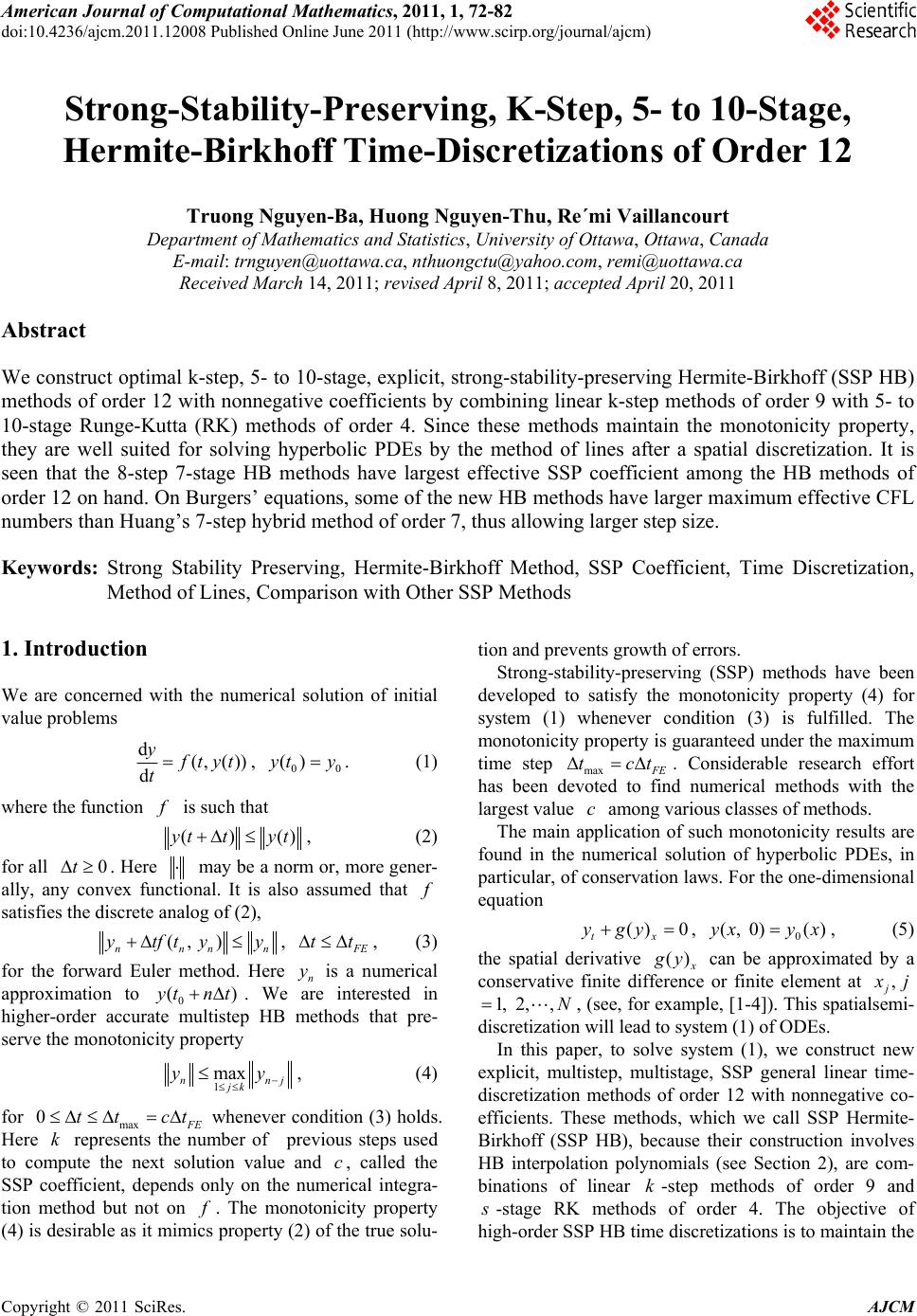 American Journal of Computational Mathematics, 2011, 1, 72-82 doi:10.4236/ajcm.2011.12008 Published Online June 2011 (http://www.scirp.org/journal/ajcm) Copyright © 2011 SciRes. AJCM Strong-Stability-Preserving, K-Step, 5- to 10-Stage, Hermite-Birkhoff Time-Discretizations of Order 12 Truong Nguyen-Ba, Huong Nguyen-Thu, Re´mi Vaillancourt Department of Mathematics and Statistics, University of Ottawa, Ottawa, Canada E-mail: trnguyen@uottawa.ca, nthuongctu@yahoo.com, remi@uottawa.ca Received March 14, 2011; revised April 8, 2011; accepted April 20, 2011 Abstract We construct optimal k-step, 5- to 10-stage, explicit, strong-stability-preserving Hermite-Birkhoff (SSP HB) methods of order 12 with nonnegative coefficients by combining linear k-step methods of order 9 with 5- to 10-stage Runge-Kutta (RK) methods of order 4. Since these methods maintain the monotonicity property, they are well suited for solving hyperbolic PDEs by the method of lines after a spatial discretization. It is seen that the 8-step 7-stage HB methods have largest effective SSP coefficient among the HB methods of order 12 on hand. On Burgers’ equations, some of the new HB methods have larger maximum effective CFL numbers than Huang’s 7-step hybrid method of order 7, thus allowing larger step size. Keywords: Strong Stability Preserving, Hermite-Birkhoff Method, SSP Coefficient, Time Discretization, Method of Lines, Comparison with Other SSP Methods 1. Introduction We are concerned with the numerical solution of initial value problems d(, ()) d y f tyt t, 00 ()yt y. (1) where the function f is such that ()() y tt yt , (2) for all 0t . Here may be a norm or, more gener- ally, any convex functional. It is also assumed that f satisfies the discrete analog of (2), (, ) nnnn y tf tyy , F E tt , (3) for the forward Euler method. Here n y is a numerical approximation to 0 ()ytn t . We are interested in higher-order accurate multistep HB methods that pre- serve the monotonicity property 1 max nnj jk yy , (4) for max 0 F E tt ct whenever condition (3) holds. Here k represents the number of previous steps used to compute the next solution value and c, called the SSP coefficient, depends only on the numerical integra- tion method but not on f . The monotonicity property (4) is desirable as it mimics property (2) of the true solu- tion and prevents growth of errors. Strong-stability-preserving (SSP) methods have been developed to satisfy the monotonicity property (4) for system (1) whenever condition (3) is fulfilled. The monotonicity property is guaranteed under the maximum time step max F E tct . Considerable research effort has been devoted to find numerical methods with the largest value c among various classes of methods. The main application of such monotonicity results are found in the numerical solution of hyperbolic PDEs, in particular, of conservation laws. For the one-dimensional equation () 0 tx ygy , 0 (, 0)()yxy x, (5) the spatial derivative () x g y can be approximated by a conservative finite difference or finite element at , j x j 1, 2,,N , (see, for example, [1-4]). This spatialsemi- discretization will lead to system (1) of ODEs. In this paper, to solve system (1), we construct new explicit, multistep, multistage, SSP general linear time- discretization methods of order 12 with nonnegative co- efficients. These methods, which we call SSP Hermite- Birkhoff (SSP HB), because their construction involves HB interpolation polynomials (see Section 2), are com- binations of linear k-step methods of order 9 and s -stage RK methods of order 4. The objective of high-order SSP HB time discretizations is to maintain the 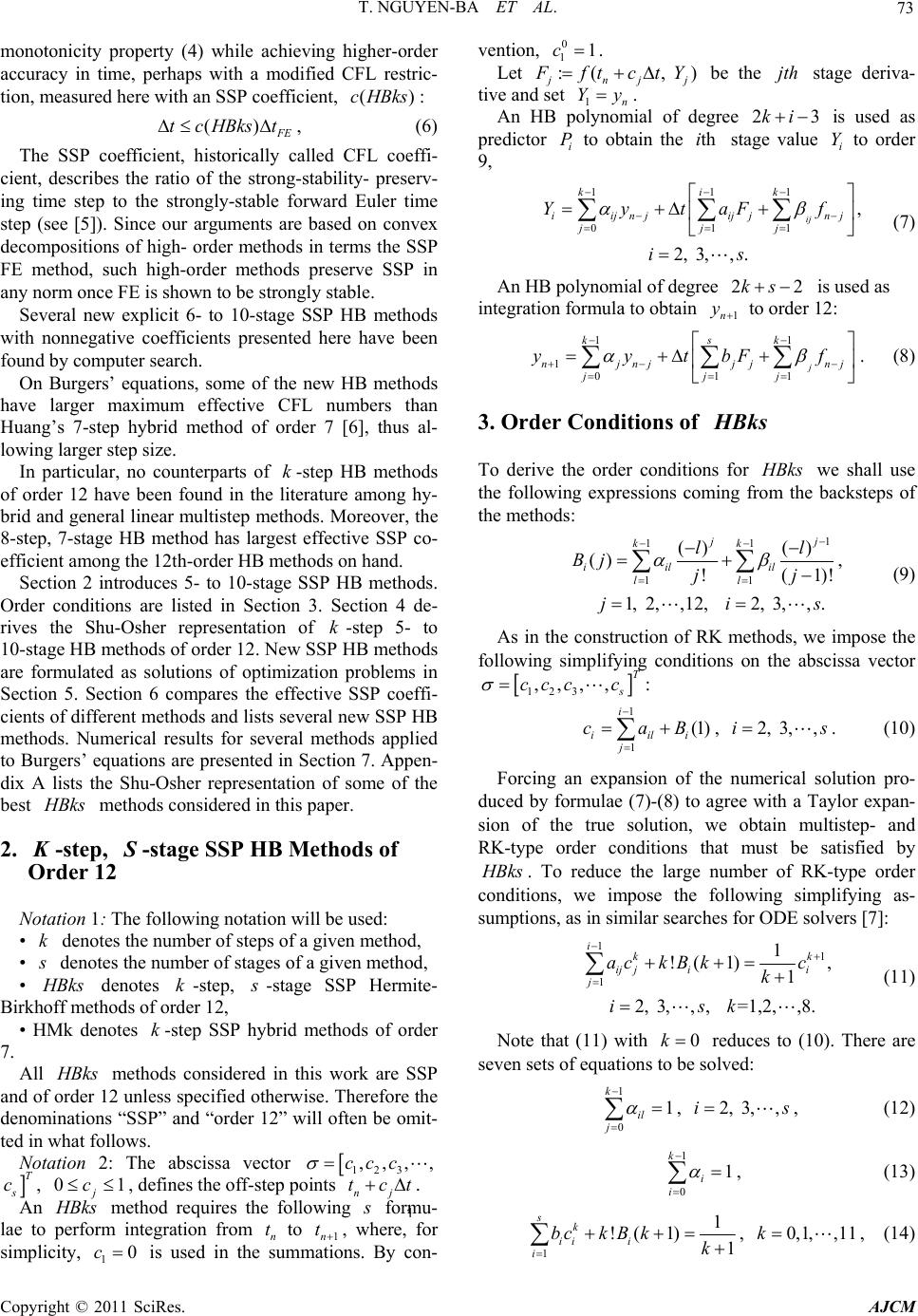 T. NGUYEN-BA ET AL. Copyright © 2011 SciRes. AJCM 73 1 monotonicity property (4) while achieving higher-order accuracy in time, perhaps with a modified CFL restric- tion, measured here with an SSP coefficient, ()cHBks: () F E tcHBkst , (6) The SSP coefficient, historically called CFL coeffi- cient, describes the ratio of the strong-stability- preserv- ing time step to the strongly-stable forward Euler time step (see [5]). Since our arguments are based on convex decompositions of high- order methods in terms the SSP FE method, such high-order methods preserve SSP in any norm once FE is shown to be strongly stable. Several new explicit 6- to 10-stage SSP HB methods with nonnegative coefficients presented here have been found by computer search. On Burgers’ equations, some of the new HB methods have larger maximum effective CFL numbers than Huang’s 7-step hybrid method of order 7 [6], thus al- lowing larger step size. In particular, no counterparts of k-step HB methods of order 12 have been found in the literature among hy- brid and general linear multistep methods. Moreover, the 8-step, 7-stage HB method has largest effective SSP co- efficient among the 12th-order HB methods on hand. Section 2 introduces 5- to 10-stage SSP HB methods. Order conditions are listed in Section 3. Section 4 de- rives the Shu-Osher representation of k-step 5- to 10-stage HB methods of order 12. New SSP HB methods are formulated as solutions of optimization problems in Section 5. Section 6 compares the effective SSP coeffi- cients of different methods and lists several new SSP HB methods. Numerical results for several methods applied to Burgers’ equations are presented in Section 7. Appen- dix A lists the Shu-Osher representation of some of the best H Bks methods considered in this paper. 2. K-step, S -stage SSP HB Methods of Order 12 Notation 1: The following notation will be used: • k denotes the number of steps of a given method, • s denotes the number of stages of a given method, • H Bks denotes k-step, s -stage SSP Hermite- Birkhoff methods of order 12, • HMk denotes k-step SSP hybrid methods of order 7. All H Bks methods considered in this work are SSP and of order 12 unless specified otherwise. Therefore the denominations “SSP” and “order 12” will often be omit- ted in what follows. Notation 2: The abscissa vector 123 ,,,,ccc T s c, 01 j c, defines the off-step points nj tct . An H Bks method requires the following s formu- lae to perform integration from n t to 1n t, where, for simplicity, 10c is used in the summations. By con- vention, 0 11c . Let :(, ) j nj j F ftc tY be the jth stage deriva- tive and set 1n Yy . An HB polynomial of degree 23ki is used as predictor i P to obtain the thi stage value i Y to order 9, 111 011 , 2, 3,,. ij kik iijnjijj nj jjj YytaFf is (7) An HB polynomial of degree 22ks is used as integration formula to obtain 1n y to order 12: 11 1011 j ksk nj njjjnj jjj yytbFf . (8) 3. Order Conditions of H Bks To derive the order conditions for H Bks we shall use the following expressions coming from the backsteps of the methods: 1 11 11 () () () , !(1)! 1, 2,,12, 2, 3,,. jj kk iil il ll ll Bj jj jis (9) As in the construction of RK methods, we impose the following simplifying conditions on the abscissa vector 123 ,,,, T s ccc c : 1 1(1) i iili j caB , 2, 3,,is. (10) Forcing an expansion of the numerical solution pro- duced by formulae (7)-(8) to agree with a Taylor expan- sion of the true solution, we obtain multistep- and RK-type order conditions that must be satisfied by H Bks . To reduce the large number of RK-type order conditions, we impose the following simplifying as- sumptions, as in similar searches for ODE solvers [7]: 11 1 1 !( 1), 1 2, 3,,, =1,2,,8. ikk ij jii j ackB kc k isk (11) Note that (11) with 0k reduces to (10). There are seven sets of equations to be solved: 1 01 k il j , 2, 3,,is, (12) 1 0 1 k i i , (13) 1 1 !( 1)1 sk ii i i bck Bkk , 0,1, ,11k, (14) 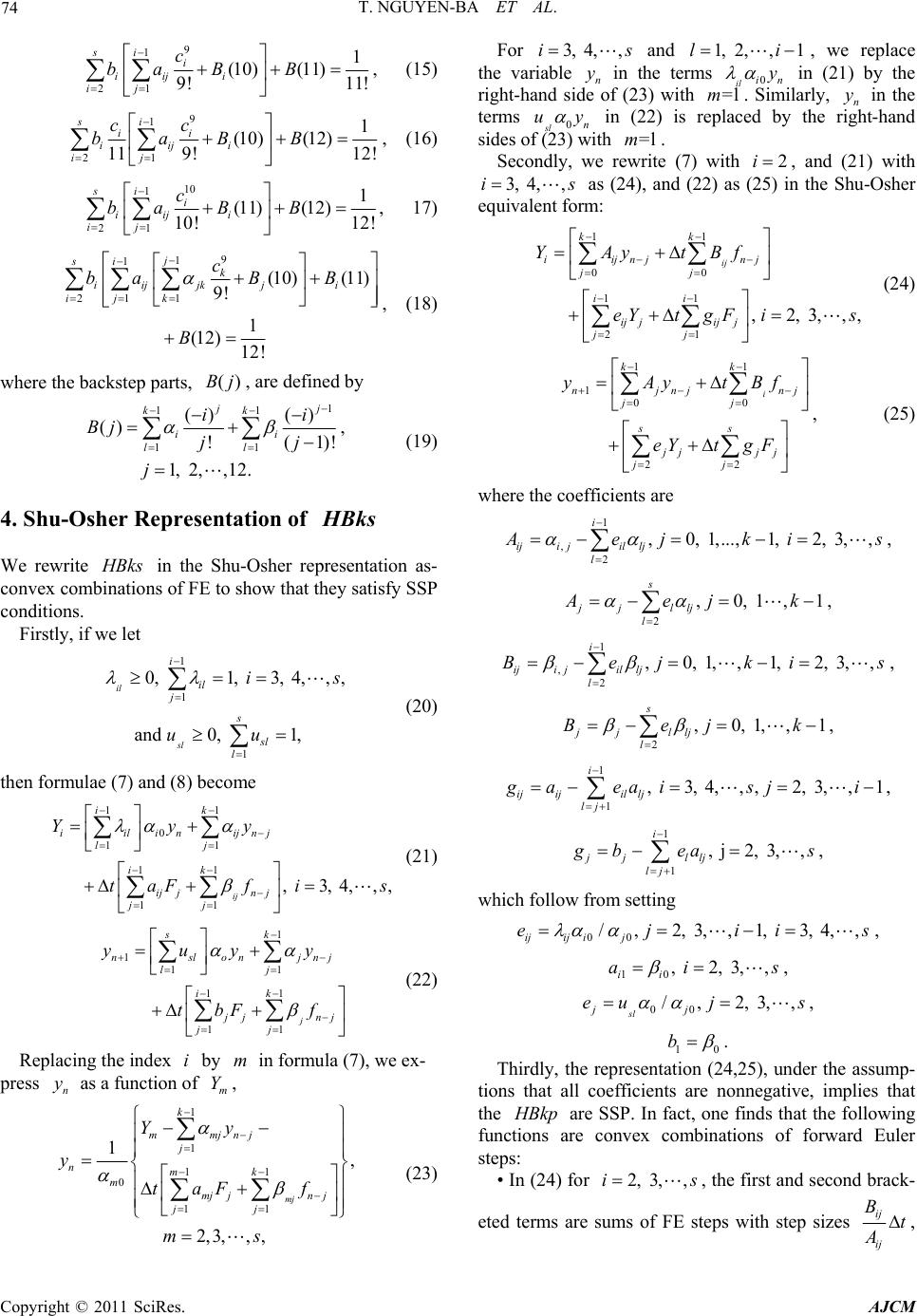 T. NGUYEN-BA ET AL. Copyright © 2011 SciRes. AJCM 74 9 1 21 1 (10) (11) 9! 11! si i iij i ij c ba BB , (15) 9 1 21 1 (10) (12) 11 9!12! si ii iiji ij cc baB B , (16) 10 1 21 1 (11) (12) 10! 12! si i iij i ij c ba BB , 17) 9 1 1 21 1 (10) (11) 9! 1 (12)12! j si k iij jkji ijk c baBB B , (18) where the backstep parts, ()Bj, are defined by 1 11 11 () () () , !(1)! 1, 2,,12. jj kk ii ll ii Bj jj j (19) 4. Shu-Osher Representation of H Bks We rewrite H Bks in the Shu-Osher representation as- convex combi natio ns of FE to show that they satisfy SSP conditions. Firstly, if we let 1 1 1 0, 1, 3, 4,,, and 0, 1, il sl i il j s sl l is uu (20) then formulae (7) and (8) become 11 0 11 11 11 , 3, 4,,, ij ik iilinijnj lj ik ijjn j jj Yyy taFf is (21) 1 111 11 11 j sk nslonjnj lj ik jj nj jj yuyy tbF f (22) Replacing the index i by m in formula (7), we ex- press n y as a function of m Y, 1 1 11 0 11 1, 2,3,,, mj k mmjnj j nmk mmjjnj jj Yy y taFf ms (23) For 3, 4,,is and 1, 2 ,,1li, we replace the variable n y in the terms 0 il in y in (21) by the right-hand side of (23) with =lm. Similarly, n y in the terms 0 sl n uy in (22) is replaced by the right-hand sides of (23) with =lm. Secondly, we rewrite (7) with 2i, and (21) with 3, 4,,is as (24), and (22) as (25) in the Shu-Osher equivalent form: 11 00 11 21 , 2, 3,,, ij kk iijnjnj jj ii ij jijj jj YAytBf eYt gFis (24) 11 100 22 i kk nj njnj jj ss jjj j jj yAytBf eYtgF , (25) where the coefficients are 1 , 2, 0, 1,...,1, 2, 3,, i iji jillj l A ej kis , 2, 0, 1,1 s jj llj l A ej k , 1 , 2 , 0, 1,,1, 2, 3,, i iji jillj l Bejkis , 2 , 0, 1,,1 s jj llj l Bejk , 1 1, 3, 4,,, 2, 3,,1 i ijijillj lj g aeai sj i , 1 1, j2, 3,, i jj llj lj g beas , which follow from setting 00 /, 2, 3,,1, 3, 4,, ijij ij ejiis , 10 , 2, 3,, ii ai s , 00 /, 2, 3,, sl jj eu js , 10 b . Thirdly, the representation (24,25), under the assump- tions that all coefficients are nonnegative, implies that the H Bkp are SSP. In fact, one finds that the following functions are convex combinations of forward Euler steps: • In (24) fo r 2, 3,,is , the first and second brack- eted terms are sums of FE steps with step sizes ij ij Bt A , 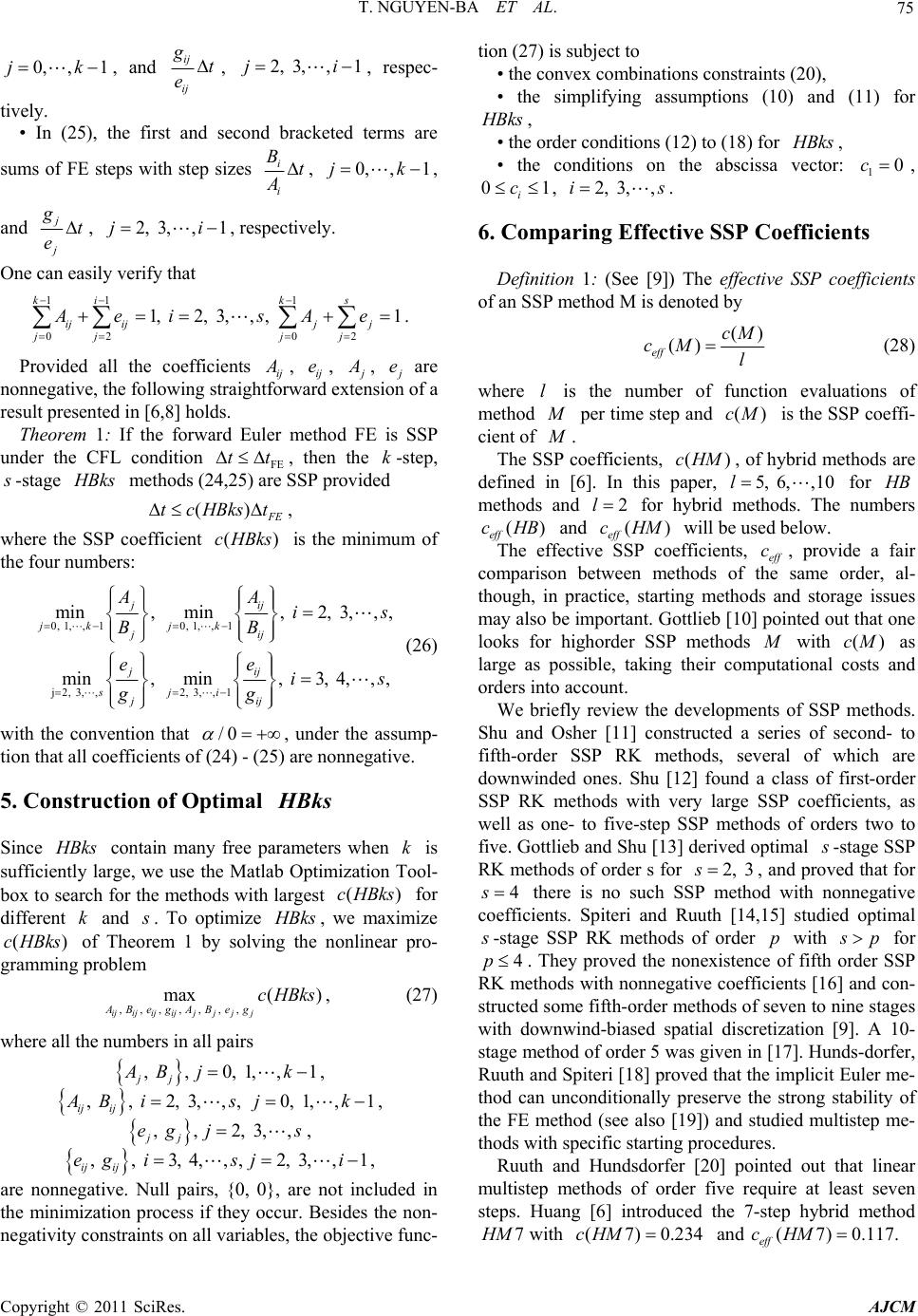 T. NGUYEN-BA ET AL. Copyright © 2011 SciRes. AJCM 75 0, ,1jk, and ij ij gt e, 2, 3,,1ji, respec- tively. • In (25), the first and second bracketed terms are sums of FE steps with step sizes i i Bt A, 0,,1jk, and j j gt e, 2, 3,,1ji, respectively. One can easily verify that 11 1 02 02 1, 2, 3,,, 1 kik s ij ijjj jj jj Aei sAe . Provided all the coefficients ij A , ij e, j A , j e are nonnegative, the following straightforward extension of a result presented in [6,8] holds. Theorem 1: If the forward Euler method FE is SSP under the CFL condition FE tt , then the k-step, s -stage H Bks methods (24,25) are SSP provided () F E tcHBkst , where the SSP coefficient ()cHBks is the minimum of the four numbers: 0, 1,,10, 1,,1 j2, 3,,2, 3,,1 min, min, 2, 3,,, min, min, 3, 4,,, jij jk jk jij jij sji jij AA is BB ee is gg (26) with the convention that /0 , under the assump- tion that all coefficients of (24) - (25) are nonnegative. 5. Construction of Optimal H Bks Since H Bks contain many free parameters when k is sufficiently large, we use the Matlab Optimization Tool- box to search for the methods with largest ()cHBks for different k and s . To optimize H Bks , we maximize ()cHBks of Theorem 1 by solving the nonlinear pro- gramming problem , , , , , , , max( ) ijijijij j jjj ABegABeg cHBks, (27) where all the numbers in all pairs , , 0, 1,,1 jj A Bj k, , , 2, 3,,, 0, 1,,1 ij ij A Bisjk , , , 2, 3,, jj eg js, , , 3, 4,,, 2, 3,,1 ij ij eg isji , are nonnegative. Null pairs, {0, 0}, are not included in the minimization process if they occur. Besides the non- negativity constraints on all variables, the objective func- tion (27) is subject to • the convex combinations constraints (20), • the simplifying assumptions (10) and (11) for H Bks , • the order conditions (12) to (18) for H Bks , • the conditions on the abscissa vector: 10c , 01 i c , 2, 3,,is . 6. Comparing Effective SSP Coefficients Definition 1: (See [9]) The effective SSP coefficients of an SSP method M is denoted by () () eff cM cM l (28) where l is the number of function evaluations of method M per time step and ()cM is the SSP coeffi- cient of M . The SSP coefficients, ()cHM, of hybrid methods are defined in [6]. In this paper, 5, 6 ,,10l for H B methods and 2l for hybrid methods. The numbers () eff cHB and () eff cHM will be used below. The effective SSP coefficients, eff c, provide a fair comparison between methods of the same order, al- though, in practice, starting methods and storage issues may also be important. Gottlieb [10] pointed out that one looks for highorder SSP methods M with ()cM as large as possible, taking their computational costs and orders into account. We briefly review the developments of SSP methods. Shu and Osher [11] constructed a series of second- to fifth-order SSP RK methods, several of which are downwinded ones. Shu [12] found a class of first-order SSP RK methods with very large SSP coefficients, as well as one- to five-step SSP methods of orders two to five. Gottlieb and Shu [13] derived optimal s -stage SSP RK methods of order s for 2, 3 s, and proved that for 4s there is no such SSP method with nonnegative coefficients. Spiteri and Ruuth [14,15] studied optimal s -stage SSP RK methods of order p with s p for 4p . They proved the nonexistence of fifth order SSP RK methods with nonnegative coefficients [16] and con- structed some fifth-order methods of seven to nine stages with downwind-biased spatial discretization [9]. A 10- stage method of order 5 was given in [17]. Hunds-dorfer, Ruuth and Spiteri [18] proved that the implicit Euler me- thod can unconditionally preserve the strong stability of the FE method (see also [19]) and studied multistep me- thods with specific starting procedures. Ruuth and Hundsdorfer [20] pointed out that linear multistep methods of order five require at least seven steps. Huang [6] introduced the 7-step hybrid method 7 H Mwith (7)0.234cHM and(7) 0.117. eff cHM  T. NGUYEN-BA ET AL. Copyright © 2011 SciRes. AJCM 76 Table 1. () eff cHBks, for , 78k, as a Function of s. s (7) eff cHBs (8) eff cHBs 5 0.010 0.057 6 0.035 0.091 7 0.060 0.096 8 0.055 0.091 9 0.051 0.083 10 0.047 0.076 In the literature, we have found no general linear methods of or d e r 12 . W e no w l ist our be st methods. 5 H Bk . Our best 5-stage SSP HBk5 method has step number 8k with (85)0.288cHB and (85) eff cHB 0.057. 6 H Bk . Our best 6-stage 6 H Bk has 8k with (86) 0.544cHB and (86)0.091 eff cHB. 7 H Bk . Our best 7-stage HBk7 have 7, 8k. Our 87 H B has largest effective SSP coefficient among the 12th-order H B methods on hand. The coefficients (87) 0.669cHB and (87) 0.096 eff cHB are listed in boldface in Tabl e 1. According to our search, it seems that (87) eff cHB cannot be improved up to 10 stages and 8 steps. The formulae of some of our best new H Bks are listed in Appendix A with their ()cHBks, () eff cHBks and abscissa vector . Table 1 lists () eff cHBks as a function of s for 7, 8k. We note that, for a given k, () eff cHBks first increases with s and then decreases. We see that (87) 0.096 eff cHB is largest for the values of k and s on hand. Definition 2: The percentage efficiency gain (PEG ) of the SSP coefficients (2) eff cM of method 2 over (1) eff cM of method 1 is (2) (1) ((2), (1))(1) eff eff eff effeff cM cM PEG cMcMcM . (29) 7. Numerical Results From now on, we use the total variation semi-norm, , 1, () nnjnj j TV yyy , (30) and say that a method is total variation diminishing (TVD ) if 1 () () nn TV yTV y . (31) We compare our new methods numerically with 7 H M of Huang. 7.1. Starting Procedure To maintain the TVD property (31), the necessary starting values for H Bkp were obtained by RK54 with small initial step size, 11.0 0.4he (approximatively). 7.2. Comparing HBks with 7HM with a Unit Downstep Initial Condition As a first comparison of H Bks of order 12 with Huang’s 7-step 7 H M of order 7 [6], we consider Bur- gers’ equation in Problem 1. Problem 1: Burgers’ equation with a unit downstep initial condition: 2 1 (, )(, )0, 2 ux tuxt tt 1, 10, (, 0)0, 01. x ux x (32) and boundary condition (1, ) 1ut for 0t. We discretize the spatial derivative of the flux func- tion 2 ()(, )/2fu uxt by the weighted essentially nonoscillatory finite difference scheme of order 5 (WENO5) of Jiang and Shu [21] with spatial stepsize 1/150x . This leads to the semi-discrete system (1/2) (1/2) 1 () jjj dutff dtx , (33) where (, ) jj uuxt with j x jx, 149,,1,j 0, 1,,150 , and (1 /2)j f is the numerical flux, which typically is a Lipschitz continuous function of several neighboring values () j ut (see [21] for details). A time discretization can then be applied to (33). We consider the total variation norm of the numerical solution at 1.8 final t . For this purpose, we let eff n be the largest effective CFL number defined as 1 max eff t t n x l , (34) such that the TV error in the numerical solution satisfies the inequality ((, ))((, 0)5.002 final TV u xtTV u xe , (35) and we let maxnum eff tlxn be the maximum nu- merical step size. Here l is the number of function evaluations per time step. We note that Inequality (35) is used because f inal tis small. Finally, we let max theor t of H Bks for Problem 1 be taken as FE max() theor tcHBkst , (36) where the SSP coefficients ()cHBks of some of the H Bks are listed in Appendix A. The numerical results for Problem 1 show that the forward Euler method, F E, has TVD property (31) with error (35) under the time step restriction  T. NGUYEN-BA ET AL. Copyright © 2011 SciRes. AJCM 77 FE 0.325tt x. (37) It was also observed numerically that the TVD prop- erty (31) holds with error (35) for the methods listed in Table 1 with max num tt . This confirms the result of Theorem 1 that H Bks are also TVD with maxt num t when combined with the WENO5 space discreti- zation since H Bks are convex combinations of F E. The same situation holds for Problem 2 below. Definition 3: The eff n percentage efficiency gain of method 2 over method 1 is (method 2)(method 1) () (method 1) eff eff eff eff nn PEG nn . (38) Table 2 lists (()) eff PEG nHBks, (7) eff nHM for H Bks and (7) 0.127 eff nHM for Problem 1. It is seen that a) (8)( 7) eff eff nHBs nHM for all 8 H Bs on hand, b) quite remarkably, even though (8) eff eff cHBsc (7)HM , in this example, 8 H Bs methods allow a larger step size since (8)( 7) eff eff nHBs nHM, c) ((8)) eff PEG nHBs, (7)0 eff nHM and increases as s increases, d) the ratios /nt R of H Bks are clearly higher than the ratio of 7 H M. For example, /(85) 7.310 nt RHB / 3.34( 7) nt RHM. The () eff nHBks, for 7, 8k, as a function of s for Problem 1 are listed in Table 3. 7.3. Comparing HBks and 7HM with a Square-Wave Initial Condition As a second comparison, we consider Burgers’ equation with a square-wave initial value in Problem 2, which is test case 4 of Laney’s five test problems [22, p.312]. Problem 2: Burgers’ equation with a square wave ini- tial condition: 2 1 (, )(, )0, 2 1, 1, 3 (, 0)0, 11. 3 ux tuxt tt x ux x (39) and boundary condition (1, )0ut for 0t. We discretize the spatial derivative of Problem 2 by WENO5 and compute the total variation of the numerical solution as a function of the effective CFL number, /( )tlx, at 0.6 final t. In this case, 0.325 eff n in the time step restriction (37) is replaced by 0.183 eff n . Table 4 lists((), (7)) eff eff PEGnHBksn HM for H Bks where (7) 0.122 eff nHM for Problem 2. It is seen that the results for Problem 2 listed in Table 4 con- Table 2. , (()(7)) eff eff PEGn HBksn HM for HBks and 7HM , and ratio //max max n tnumtheor R tt for Problem 1. Here ()70.127 eff nHM and (). /73 340 nt RHM. H Bks () eff nHB /nt R PEG 85 H B0.137 7.310 8% 86 H B0.170 5.772 34% 77 H B0.145 7.402 14% 87 H B0.210 6.756 65% Table 3. () eff nHBks, for HBks HBks applied to Problem 1. s (7) eff nHBs (8) eff nHBs 5 0.075 0.137 6 0.084 0.170 7 0.145 0.210 Table 4. (, ee ()(7)) ff ff PEGn HBksn HM for HBks and 7HM , and ratio // nmax max tnum theor R tt for Problem 2. Here . e(7)0 122 ff nHM and () t/75.689 n RHM. H Bks () eff nHB /nt R PEG 85 H B 0.137 12.999 12% 86 H B 0.158 9.541 30% 77 H B 0.138 12.536 14% 87 H B 0.203 11.608 67% Table 5. ef() f nHBks, for HBks applied to Problem 2. s (7) eff nHBs (8) eff nHBs 5 0.075 0.137 6 0.083 0.158 7 0.138 0.20 firm the observations (a-d) obtained for Problem 1 as listed in Table 2. We observe that, as with hybrid methods, the ratio max/max num theor tt of H Bks for Problems 1 and 2 are greater than 1. The theo retical stro ng-stability b ounds of H Bks are thus verified in the numerical comparison of the maximum time steps for Problem 1 and confirmed again with Problem 2. Table 5 lists () eff nHBks for 7, 8k as a function s for Problem 2. 8. Conclusions New optimal explicit k-step, s -stage (5, 6, ...,10s) SSP Hermite-Birkhoff methods, H Bks, of orders 12 with nonnegative coefficients are constructed by combin- ing linear k-step methods of order 9 with 5- to 10-stage Runge-Kutta methods of order 4. No counterparts of H Bks of order 12 have been found in the literature among hybrid and general linear multistep methods.  T. NGUYEN-BA ET AL. Copyright © 2011 SciRes. AJCM 78 Moreover, the 8-step 7-stage 87 H B has largest effec- tive SSP coefficient among the 12th-order H B meth- ods on hand. It is found that some of new H Bks have larger effective SSP coefficients and larger maximum effective CFL numbers than Huang’s 7-step hybrid method of or de r 7 on Burgers’ equation s . 9. References [1] A. Harten, “High Resolution Schemes for Hyperbolic Conservation Laws,” Journal of Computational Physics Vol. 49, No. 3, 1983, pp. 357-393. doi:10.1016/0021-9991(83)90136-5 [2] S. Osher and S. Chakravarthy , “High Resolution Schemes and the Entropy Condition,” SIAM Journal on Numerical Analysis, Vol. 21, No. 5, 1984, pp. 955-984. doi:10.1137/0721060 [3] P. K. Sweby, “High Resolution Schemes Using Flux Limiters for Hyperbolic Conservation Laws,” SIAM Journal on Numerical Analysis, Vol. 21, No. 5, 1984, pp. 995-1011. doi:10.1137/0721062 [4] B. Cockburn and C. W. Shu, “TVB Runge-Kutta Local Projection Discontinuous Galerkin Finite Element Method for Conservation Laws II: General Framework,” Mathematics of Computation, Vol. 52, No. 186, 1989, pp. 411-435. [5] S. Gottlieb, D. I. Ketcheson and C. W. Shu, “High Order Strong Stability Preserving Time Discretization,” Journal of Scientific Computing, Vol. 38, No. 3, 2009, pp. 251-289. [6] C. Huang, “Strong Stability Preserving Hybrid Methods,” Applied Numerical Mathematics, Vol. 59, No. 5, 2009, pp. 891-904. doi:10.1016/j.apnum.2008.03.030 [7] T. Nguyen-Ba, E. Kengne and R. Vaillancourt, “One-Step 4-Stage Hermite-Birkhoff-Taylor ODE Solver of Order 12,” The Canadian Applied Mathematics Quar- terly, Vol. 16, No. 1, 2008, pp. 77-94. [8] S. Gottlieb, C. W. Shu and E. Tadmor, “Strong Stability- Preserving Highorder Time Discretization Methods,” SIAM Review, Vol. 43, No. 1, 2001, pp. 8-112 doi:10.1137/S003614450036757X [9] S. J. Ruuth and R. J. Spiteri, “High-Order Strong-Stabil- ity-Preserving Runge-Kutta Methods with Down-Biased Spatial Discretizations,” SIAM Journal on Numerical Analysis, Vol. 42, No. 3, 2004, pp. 974-996. doi:10.1137/S0036142902419284 [10] S. Gottlieb, “On High Order Strong Stability Preserving Runge-Kuttaand Multi Step Time Discretizations,” Jour- nal of Scientific Computing, Vol. 25, No. 1-2, 2005, pp. 105-128. [11] C. W. Shu and S. Osher, “Efficient Implementation of Essentially Nonoscillatory Shock-Capturing Schemes,” Journal of Scientific Computing, Vol. 77, No. 2, 1988, pp. 439-471. doi:10.1016/0021-9991(88)90177-5 [12] C. W. Shu, “Total-Variation-Diminishing Time Discreti- zations,” SIAM Journal on Numerical Analysis, Vol. 9, No. 6, 1988, pp. 1073-1084. doi:10.1137/0909073 [13] S. Gottlieb and C. W. Shu, “Total Variation Diminishing Runge-Kutta Schemes,” Mathematics of Computation, Vol. 67, No. 221, 1998, pp. 73-85. doi:10.1090/S0025-5718-98-00913-2 [14] R. J. Spiteri and S. J. Ruth, “A New Class of Optimal High-Order Strong-Stability-Preserving Time-Stepping Schemes,” SIAM Journal on Numerical Analysis, Vol. 40, No. 2, 2002, pp. 469-491. doi:10.1137/S0036142901389025 [15] R. J. Spiteri, S. J. Ruuh, “Nolinear Evoluton Using Opti- mal Fourth-Order Strong-Stability-Preserving Runge- Kutta Methods, Journal of Mathematics and Computers in Simulation, Vol. 62, No. 1-2, 2003, pp. 125-135. doi:10.1016/S0378-4754(02)00179-9 [16] S. J. Ruuth and R. J. Piteri, “Two Barriers on Strong- Stability-Preserving Time Discretization Methods,” Journal on Scientific Computing, Vol. 17, No. 1-4, 2002, pp. 211-220. doi:10.1023/A:1015156832269 [17] S. J. Ruuth, “Global Optimization of Explicit Strong- Stability-Preserving Runge-Kutta Methods,” Mathemat- ics of Computation, Vol. 75, No. 253, 2006, pp. 183-207. doi:10.1090/S0025-5718-05-01772-2 [18] W. Hundsdorfer, S. J. Ruuth and R. J. Spiteri, “Monotonicity Preserving Linear Multistep Methods,” SIAM Journal on Numerical Analysis, Vol. 41, No. , 2003, pp. 605-623. doi:10.1137/S0036142902406326 [19] I. Higueras, “On Strong Stability Preserving Methods,” Journal of Scientific Computing, Vol. 21, No. , 2004, pp. 193-223. doi:10.1023/B:JOMP.0000030075.59237.61 [20] S. J. Ruuth and W. Hundsdorfer, “High-Order Linear Multistep Methods with General Monotonicity and Boundedness Properties,” Journal of Computational Physics, Vol. 209, No. 1, 2005, pp. 226-248. doi:10.1016/j.jcp.2005.02.029 [21] G. Jiang and C. W. Shu, “Efficient Implementation of Weighted ENO Schemes,” Journal of Computational Physics, Vol. 126, No. 1, 1996, pp. 202-228. doi:10.1006/jcph.1996.0130 [22] C. Laney, “Computational Gasdynamics,” Cambridge University Press, Cambridge, 1998. doi:10.1017/CBO9780511605604 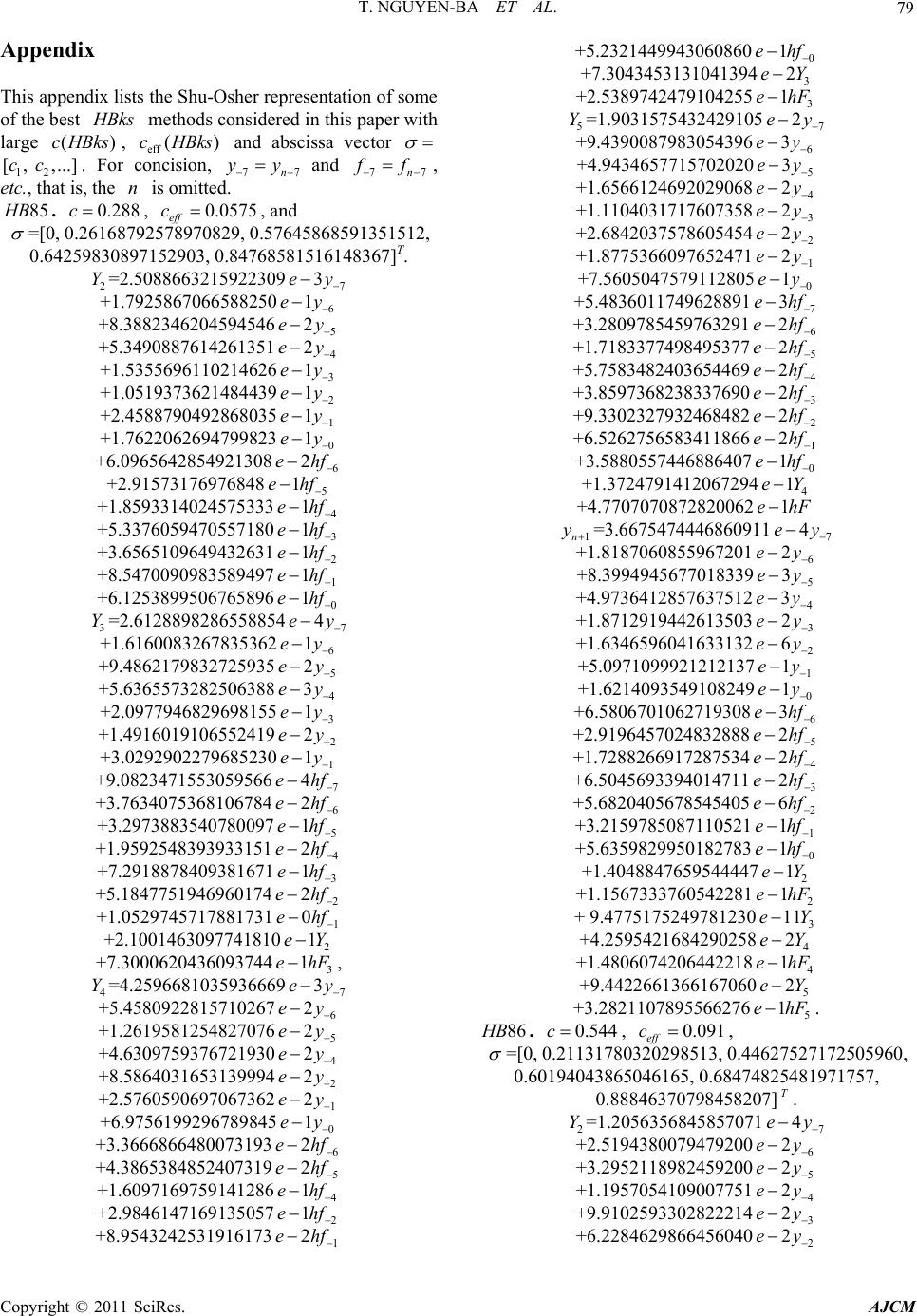 T. NGUYEN-BA ET AL. Copyright © 2011 SciRes. AJCM 79 Appendix This appendix lists the Shu-Osh er represen tation of some of the best H Bks methods considered in th is paper with large ()cHBks , eff ()cHBks and abscissa vector 12 [, ,...]cc . For concision, 77n yy and 77n f f , etc., that is, the n is omitted. 85 H B. 0.288c, 0.0575 eff c, and =[0, 0.26168792578970829, 0.57645868591351512, 0.64259830897152903, 0.84768581516148367]T. 2 Y=2.5088663215922309 7 3ey +1.7925867066588250 6 1ey +8.3882346204594546 5 2ey +5.3490887614261351 4 2ey +1.5355696110214626 3 1ey +1.0519373621484439 2 1ey +2.4588790492868035 1 1ey +1.7622062694799823 0 1ey +6.0965642854921308 6 2ehf +2.91573176976848 5 1ehf +1.8593314024575333 4 1ehf +5.3376059470557180 3 1ehf +3.6565109649432631 2 1ehf +8.5470090983589497 1 1ehf +6.1253899506765896 0 1ehf 3 Y=2.6128898286558854 7 4ey +1.6160083267835362 6 1ey +9.4862179832725935 5 2ey +5.6365573282506388 4 3ey +2.0977946829698155 3 1ey +1.4916019106552419 2 2ey +3.0292902279685230 1 1ey +9.0823471553059566 7 4ehf +3.7634075368106784 6 2ehf +3.2973883540780097 5 1ehf +1.9592548393933151 4 2ehf +7.2918878409381671 3 1ehf +5.1847751946960174 2 2ehf +1.0529745717881731 1 0ehf +2.1001463097741810 2 1eY +7.3000620436093744 3 1ehF, 4 Y=4.2596681035936669 7 3ey +5.4580922815710267 6 2ey +1.2619581254827076 5 2ey +4.6309759376721930 4 2ey +8.5864031653139994 2 2ey +2.5760590697067362 1 2ey +6.9756199296789845 0 1ey +3.3666866480073193 6 2ehf +4.3865384852407319 5 2ehf +1.6097169759141286 4 1ehf +2.9846147169135057 2 1ehf +8.9543242531916173 1 2ehf +5.2321449943060860 0 1ehf +7.3043453131041394 3 2eY +2.5389742479104255 3 1ehF 5 Y=1.9031575432429105 7 2ey +9.4390087983054396 6 3ey +4.9434657715702020 5 3ey +1.6566124692029068 4 2ey +1.1104031717607358 3 2ey +2.6842037578605454 2 2ey +1.8775366097652471 1 2ey +7.5605047579112805 0 1ey +5.4836011749628891 7 3ehf +3.2809785459763291 6 2ehf +1.7183377498495377 5 2ehf +5.7583482403654469 4 2ehf +3.8597368238337690 3 2ehf +9.3302327932468482 2 2ehf +6.5262756583411866 1 2ehf +3.5880557446886407 0 1ehf +1.3724791412067294 4 1eY +4.7707070872820062 1ehF 1n y =3.6675474446860911 7 4ey +1.8187060855967201 6 2ey +8.3994945677018339 5 3ey +4.9736412857637512 4 3ey +1.8712919442613503 3 2ey +1.6346596041633132 2 6ey +5.0971099921212137 1 1ey +1.6214093549108249 0 1ey +6.5806701062719308 6 3ehf +2.9196457024832888 5 2ehf +1.7288266917287534 4 2ehf +6.5045693394014711 3 2ehf +5.6820405678545405 2 6ehf +3.2159785087110521 1 1ehf +5.6359829950182783 0 1ehf +1.4048847659544447 2 1eY +1.1567333760542281 2 1ehF + 9.47751752497812303 11eY +4.2595421684290258 4 2eY +1.4806074206442218 4 1ehF +9.4422661366167060 5 2eY +3.2821107895566276 5 1ehF. 86 H B. 0.544c , 0.091 eff c , =[0, 0.21131780320298513, 0.44627527172505960, 0.60194043865046165, 0.68474825481971757, 0.88846370798458207]T. 2 Y=1.2056356845857071 7 4ey +2.5194380079479200 6 2ey +3.2952118982459200 5 2ey +1.1957054109007751 4 2ey +9.9102593302822214 3 2ey +6.2284629866456040 2 2ey 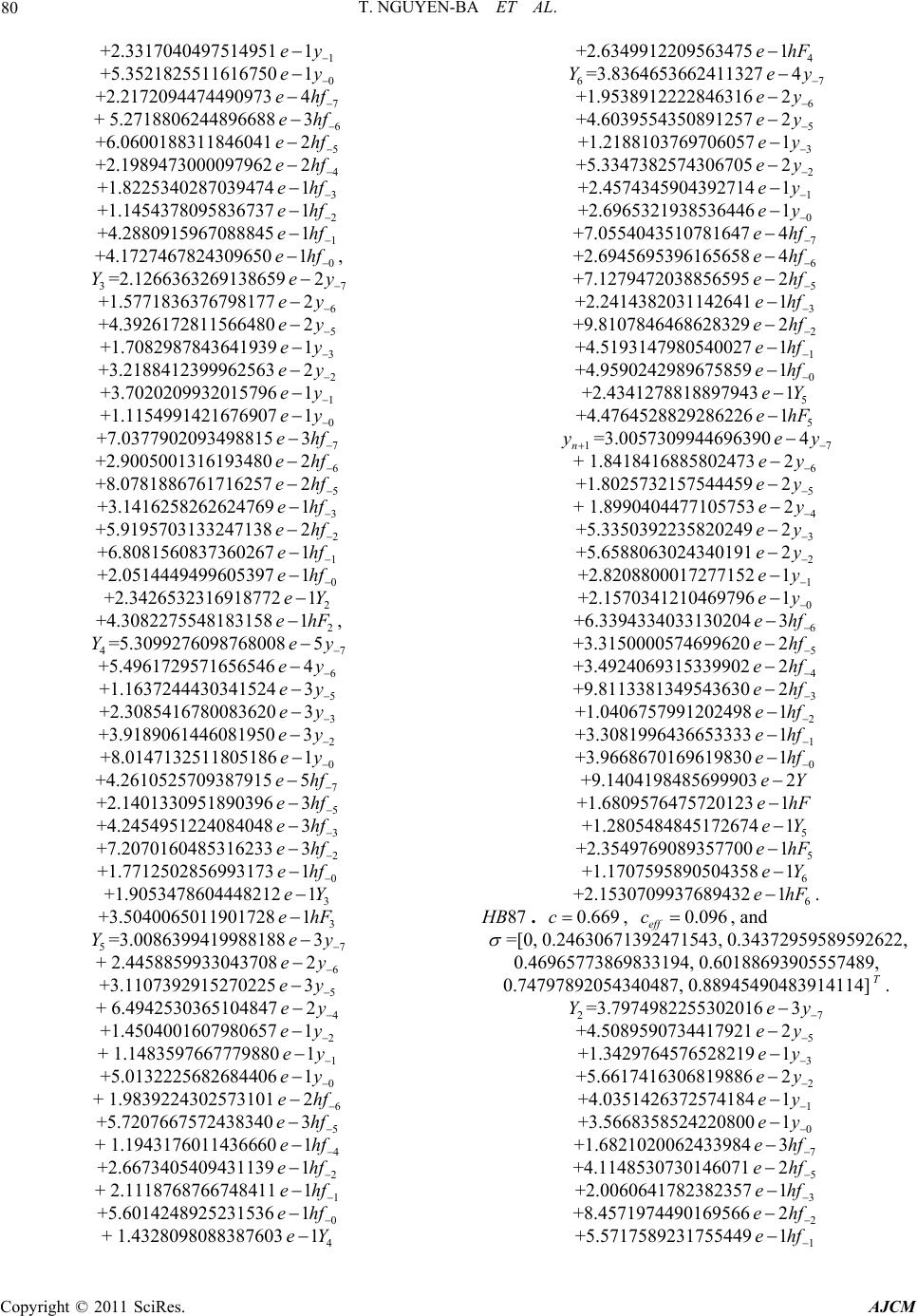 T. NGUYEN-BA ET AL. Copyright © 2011 SciRes. AJCM 80 +2.3317040497514951 1 1ey +5.3521825511616750 0 1ey +2.2172094474490973 7 4ehf + 5.27188062448966886 3ehf +6.0600188311846041 5 2ehf +2.1989473000097962 4 2ehf +1.8225340287039474 3 1ehf +1.1454378095836737 2 1ehf +4.2880915967088845 1 1ehf +4.1727467824309650 0 1ehf , 3 Y=2.1266363269138659 7 2ey +1.5771836376798177 6 2ey +4.3926172811566480 5 2ey +1.7082987843641939 3 1ey +3.2188412399962563 2 2ey +3.7020209932015796 1 1ey +1.1154991421676907 0 1ey +7.0377902093498815 7 3ehf +2.9005001316193480 6 2ehf +8.0781886761716257 5 2ehf +3.1416258262624769 3 1ehf +5.9195703133247138 2 2ehf +6.8081560837360267 1 1ehf +2.0514449499605397 0 1ehf +2.3426532316918772 2 1eY +4.3082275548183158 2 1ehF, 4 Y=5.3099276098768008 7 5ey +5.4961729571656546 6 4ey +1.1637244430341524 5 3ey +2.3085416780083620 3 3ey +3.9189061446081950 2 3ey +8.0147132511805186 0 1ey +4.2610525709387915 7 5ehf +2.1401330951890396 5 3ehf +4.2454951224084048 3 3ehf +7.2070160485316233 2 3ehf +1.7712502856993173 0 1ehf +1.9053478604448212 3 1eY +3.5040065011901728 3 1ehF 5 Y=3.0086399419988188 7 3ey + 2.44588599330437086 2ey +3.1107392915270225 5 3ey + 6.49425303651048474 2ey +1.4504001607980657 2 1ey + 1.14835976677798801 1ey +5.0132225682684406 0 1ey + 1.98392243025731016 2ehf +5.7207667572438340 5 3ehf + 1.19431760114366604 1ehf +2.6673405409431139 2 1ehf + 2.11187687667484111 1ehf +5.6014248925231536 0 1ehf + 1.43280980883876034 1eY +2.6349912209563475 4 1ehF 6 Y=3.8364653662411327 7 4ey +1.9538912222846316 6 2ey +4.6039554350891257 5 2ey +1.2188103769706057 3 1ey +5.3347382574306705 2 2ey +2.4574345904392714 1 1ey +2.6965321938536446 0 1ey +7.0554043510781647 7 4ehf +2.6945695396165658 6 4ehf +7.1279472038856595 5 2ehf +2.2414382031142641 3 1ehf +9.8107846468628329 2 2ehf +4.5193147980540027 1 1ehf +4.9590242989675859 0 1ehf +2.4341278818897943 5 1eY +4.4764528829286226 5 1ehF 1n y =3.0057309944696390 7 4ey + 1.84184168858024736 2ey +1.8025732157544459 5 2ey + 1.89904044771057534 2ey +5.3350392235820249 3 2ey +5.6588063024340191 2 2ey +2.8208800017277152 1 1ey +2.1570341210469796 0 1ey +6.3394334033130204 6 3ehf +3.3150000574699620 5 2ehf +3.4924069315339902 4 2ehf +9.8113381349543630 3 2ehf +1.0406757991202498 2 1ehf +3.3081996436653333 1 1ehf +3.9668670169619830 0 1ehf +9.1404198485699903 2eY +1.6809576475720123 1ehF +1.2805484845172674 5 1eY +2.3549769089357700 5 1ehF +1.1707595890504358 6 1eY +2.1530709937689432 6 1ehF. 87 H B. 0.669c , 0.096 eff c , and =[0, 0.24630671392471543, 0.34372959589592622, 0.46965773869833194, 0.60188693905557489, 0.74797892054340487, 0.88945490483914114]T. 2 Y=3.7974982255302016 7 3ey +4.5089590734417921 5 2ey +1.3429764576528219 3 1ey +5.6617416306819886 2 2ey +4.0351426372574184 1 1ey +3.5668358524220800 0 1ey +1.6821020062433984 7 3ehf +4.1148530730146071 5 2ehf +2.0060641782382357 3 1ehf +8.4571974490169566 2 2ehf +5.5717589231755449 1 1ehf 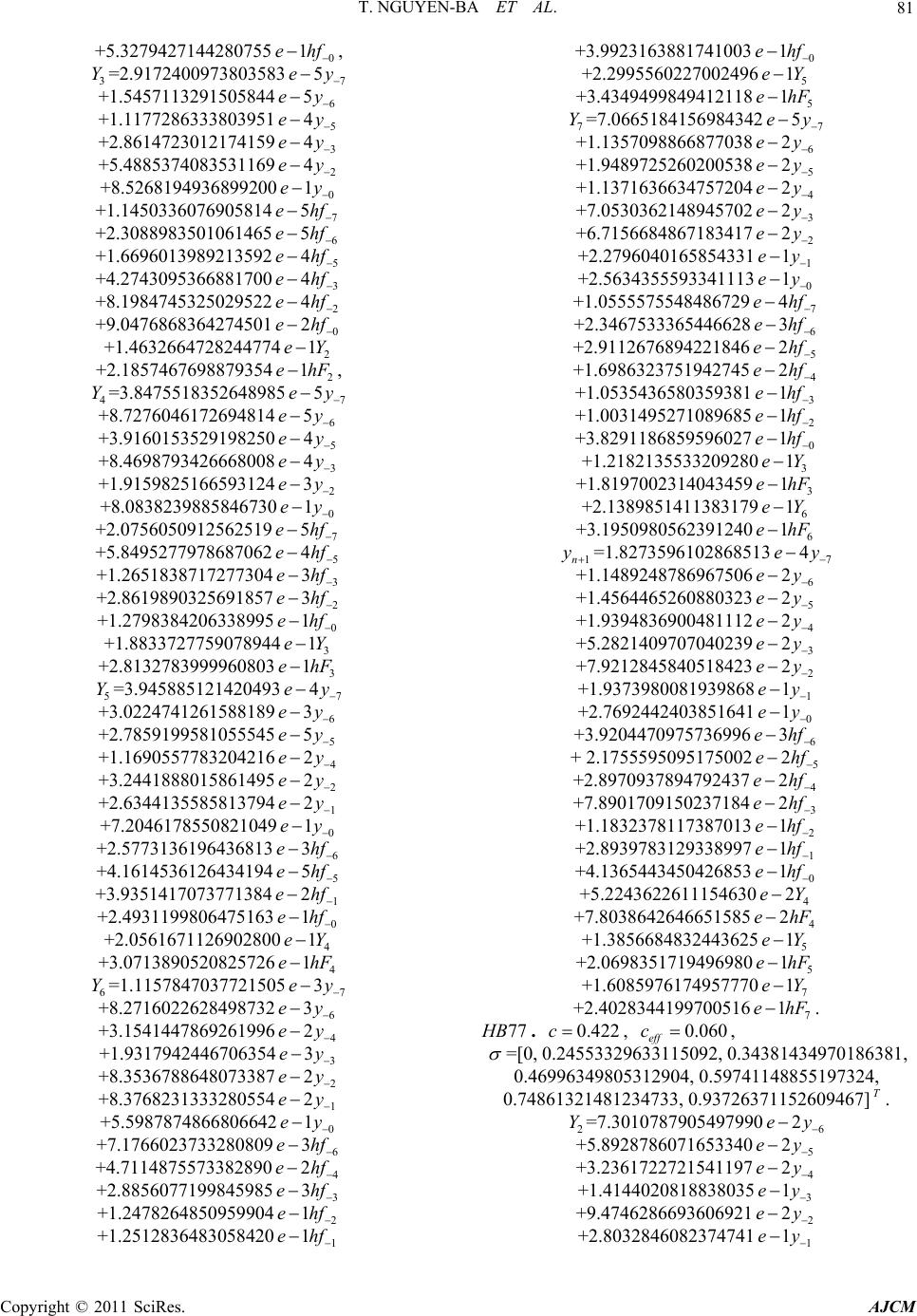 T. NGUYEN-BA ET AL. Copyright © 2011 SciRes. AJCM 81 +5.3279427144280755 0 1ehf , 3 Y=2.9172400973803583 7 5ey +1.5457113291505844 6 5ey +1.1177286333803951 5 4ey +2.8614723012174159 3 4ey +5.4885374083531169 2 4ey +8.5268194936899200 0 1ey +1.1450336076905814 7 5ehf +2.3088983501061465 6 5ehf +1.6696013989213592 5 4ehf +4.2743095366881700 3 4ehf +8.1984745325029522 2 4ehf +9.0476868364274501 0 2ehf +1.4632664728244774 2 1eY +2.1857467698879354 2 1ehF, 4 Y=3.8475518352648985 7 5ey +8.7276046172694814 6 5ey +3.9160153529198250 5 4ey +8.4698793426668008 3 4ey +1.9159825166593124 2 3ey +8.0838239885846730 0 1ey +2.0756050912562519 7 5ehf +5.8495277978687062 5 4ehf +1.2651838717277304 3 3ehf +2.8619890325691857 2 3ehf +1.2798384206338995 0 1ehf +1.8833727759078944 3 1eY +2.8132783999960803 3 1ehF 5 Y=3.945885121420493 7 4ey +3.0224741261588189 6 3ey +2.7859199581055545 5 5ey +1.1690557783204216 4 2ey +3.2441888015861495 2 2ey +2.6344135585813794 1 2ey +7.2046178550821049 0 1ey +2.5773136196436813 6 3ehf +4.1614536126434194 5 5ehf +3.9351417073771384 1 2ehf +2.4931199806475163 0 1ehf +2.0561671126902800 4 1eY +3.0713890520825726 4 1ehF 6 Y=1.1157847037721505 7 3ey +8.2716022628498732 6 3ey +3.1541447869261996 4 2ey +1.9317942446706354 3 3ey +8.3536788648073387 2 2ey +8.3768231333280554 1 2ey +5.5987874866806642 0 1ey +7.1766023733280809 6 3ehf +4.7114875573382890 4 2ehf +2.8856077199845985 3 3ehf +1.2478264850959904 2 1ehf +1.2512836483058420 1 1ehf +3.9923163881741003 0 1ehf +2.2995560227002496 5 1eY +3.4349499849412118 5 1ehF 7 Y=7.0665184156984342 7 5ey +1.1357098866877038 6 2ey +1.9489725260200538 5 2ey +1.1371636634757204 4 2ey +7.0530362148945702 3 2ey +6.7156684867183417 2 2ey +2.2796040165854331 1 1ey +2.5634355593341113 0 1ey +1.0555575548486729 7 4ehf +2.3467533365446628 6 3ehf +2.9112676894221846 5 2ehf +1.6986323751942745 4 2ehf +1.0535436580359381 3 1ehf +1.0031495271089685 2 1ehf +3.8291186859596027 0 1ehf +1.2182135533209280 3 1eY +1.8197002314043459 3 1ehF +2.1389851411383179 6 1eY +3.1950980562391240 6 1ehF 1n y =1.8273596102868513 7 4ey +1.1489248786967506 6 2ey +1.4564465260880323 5 2ey +1.9394836900481112 4 2ey +5.2821409707040239 3 2ey +7.9212845840518423 2 2ey +1.9373980081939868 1 1ey +2.7692442403851641 0 1ey +3.9204470975736996 6 3ehf + 2.17555950951750025 2ehf +2.8970937894792437 4 2ehf +7.8901709150237184 3 2ehf +1.1832378117387013 2 1ehf +2.8939783129338997 1 1ehf +4.1365443450426853 0 1ehf +5.2243622611154630 4 2eY +7.8038642646651585 4 2ehF +1.3856684832443625 5 1eY +2.0698351719496980 5 1ehF +1.6085976174957770 7 1eY +2.4028344199700516 7 1ehF. 77 H B. 0.422c , 0.060 eff c , =[0, 0.24553329633115092, 0.34381434970186381, 0.46996349805312904, 0.59741148855197324, 0.74861321481234733, 0.93726371152609467]T. 2 Y=7.3010787905497990 6 2ey +5.8928786071653340 5 2ey +3.2361722721541197 4 2ey +1.4144020818838035 3 1ey +9.4746286693606921 2 2ey +2.8032846082374741 1 1ey 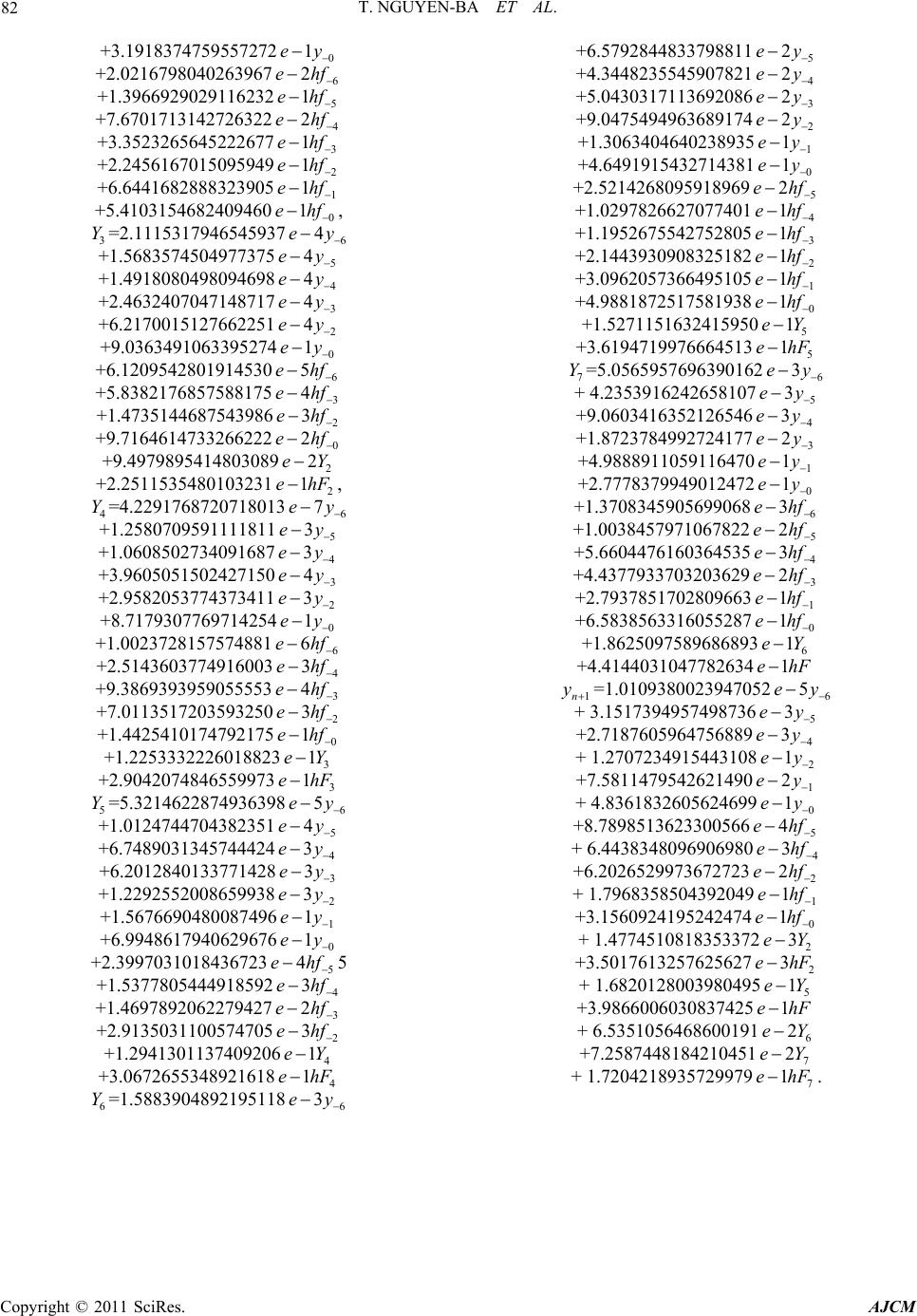 T. NGUYEN-BA ET AL. Copyright © 2011 SciRes. AJCM 82 +3.1918374759557272 0 1ey +2.0216798040263967 6 2ehf +1.3966929029116232 5 1ehf +7.6701713142726322 4 2ehf +3.3523265645222677 3 1ehf +2.2456167015095949 2 1ehf +6.6441682888323905 1 1ehf +5.4103154682409460 0 1ehf , 3 Y=2.1115317946545937 6 4ey +1.5683574504977375 5 4ey +1.4918080498094698 4 4ey +2.4632407047148717 3 4ey +6.2170015127662251 2 4ey +9.0363491063395274 0 1ey +6.1209542801914530 6 5ehf +5.8382176857588175 3 4ehf +1.4735144687543986 2 3ehf +9.7164614733266222 0 2ehf +9.4979895414803089 2 2eY +2.2511535480103231 2 1ehF, 4 Y=4.2291768720718013 6 7ey +1.2580709591111811 5 3ey +1.0608502734091687 4 3ey +3.9605051502427150 3 4ey +2.9582053774373411 2 3ey +8.7179307769714254 0 1ey +1.0023728157574881 6 6ehf +2.5143603774916003 4 3ehf +9.3869393959055553 3 4ehf +7.0113517203593250 2 3ehf +1.4425410174792175 0 1ehf +1.2253332226018823 3 1eY +2.9042074846559973 3 1ehF 5 Y=5.3214622874936398 6 5ey +1.0124744704382351 5 4ey +6.7489031345744424 4 3ey +6.2012840133771428 3 3ey +1.2292552008659938 2 3ey +1.5676690480087496 1 1ey +6.9948617940629676 0 1ey +2.3997031018436723 5 4ehf 5 +1.5377805444918592 4 3ehf +1.4697892062279427 3 2ehf +2.9135031100574705 2 3ehf +1.2941301137409206 4 1eY +3.0672655348921618 4 1ehF 6 Y=1.5883904892195118 6 3ey +6.5792844833798811 5 2ey +4.3448235545907821 4 2ey +5.0430317113692086 3 2ey +9.0475494963689174 2 2ey +1.3063404640238935 1 1ey +4.6491915432714381 0 1ey +2.5214268095918969 5 2ehf +1.0297826627077401 4 1ehf +1.1952675542752805 3 1ehf +2.1443930908325182 2 1ehf +3.0962057366495105 1 1ehf +4.9881872517581938 0 1ehf +1.5271151632415950 5 1eY +3.6194719976664513 5 1ehF 7 Y=5.0565957696390162 6 3ey + 4.23539162426581075 3ey +9.0603416352126546 4 3ey +1.8723784992724177 3 2ey +4.9888911059116470 1 1ey +2.7778379949012472 0 1ey +1.3708345905699068 6 3ehf +1.0038457971067822 5 2ehf +5.6604476160364535 4 3ehf +4.4377933703203629 3 2ehf +2.7937851702809663 1 1ehf +6.5838563316055287 0 1ehf +1.8625097589686893 6 1eY +4.4144031047782634 1ehF 1n y =1.0109380023947052 6 5ey + 3.15173949574987365 3ey +2.7187605964756889 4 3ey + 1.27072349154431082 1ey +7.5811479542621490 1 2ey + 4.83618326056246990 1ey +8.7898513623300566 5 4ehf + 6.44383480969069804 3ehf +6.2026529973672723 2 2ehf + 1.79683585043920491 1ehf +3.1560924195242474 0 1ehf + 1.47745108183533722 3eY +3.5017613257625627 2 3ehF + 1.68201280039804955 1eY +3.9866006030837425 1ehF + 6.53510564686001916 2eY +7.2587448184210451 7 2eY + 1.72042189357299797 1ehF. |

